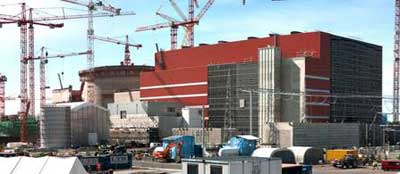
European
Nuclear Society
e-news
Issue 29 Summer 2010
http://www.euronuclear.org/e-news/e-news-28/finnish-society.htm

The installation of the reactor pressure vessel (RPV) for the third power unit at Olkiluoto nuclear power plant took place on 21 June 2010. Measuring 5.3 meters in diameter and 10.6 meters in height, the 420 tonnes component was installed using two cranes: the permanent polar crane and a large movable unit.
Total manpower working at the Olkiluoto 3 site at present numbers 3900 and the percentage of that total made up by installation workers is increasing. The main components of the turbine island have already been installed and the installation of the primary circuit components has started. After the RPV the reactor coolant piping and the housings of the main reactor coolant pumps will follow next. The first of the four steam generators will be lifted into the reactor building towards the end of the summer.

The most visible construction operation in progress at the moment is the concreting of the inner dome part of the reactor building. A thin layer of concrete has already been poured on top of the steel liner, and a second thicker layer of concrete is yet to be poured. This operation is expected to be completed during the summer.
Pictures of the RPV emplacement are available from TVO's image gallery (www.tvo.fi/www/page/2733/).
ONKALO, the underground rock characterisation facility excavated in the Olkiluoto bedrock, will reach its final disposal depth in June.
Started in 2004, the tunnel excavation and research carried out during the work have enhanced the knowledge provided by above ground drilling and measurements of the suitability of the Olkiluoto bedrock for the final disposal of spent nuclear fuel. In addition to underground research, bedrock investigations will also be continued above ground. Currently, the 54th deep research hole is being drilled in Olkiluoto.
The excavation of ONKALO has continued to a depth where the properties of the bedrock represent those of the final repository. The properties will be studied in greater detail in the ONKALO research niches. A total of five research niches are used for studying bedrock stress, hydrochemistry, and water conductivity. Posiva has launched an experiment at a depth of 350 metres, studying the impact of bedrock stress. Posiva will drill three holes of 1.5 metres in diameter and 7 meters deep.
Two test and demonstration tunnels will be excavated at the final disposal depth so that their design and implementation correspond with those of the final disposal tunnels. The primary objective is to indicate the readiness to identify a suitable bedrock volume for the final disposal tunnels and canister holes, and to excavate the tunnels according to requirements. In addition to the test and demonstration tunnels, Posiva will excavate equipment and maintenance facilities deep into the bedrock. The planned excavation will be completed by the end of 2011.
Currently, the above ground construction of ONKALO is focused on the foundations of the ventilation and hoist building. The objective is that the ONKALO facility will be ventilated through the ventilation building in 2011.
Posiva organised a topping-out ceremony in ONKALO, on 17 June 2010 to mark the reaching of the final disposal depth of 420 metres.
Pictures of ONKALO and the topping-out ceremony are available on the Posiva website (www.posiva.fi/en/databank/image_gallery ).
The monthly meeting of the Finnish Nuclear Society (ATS) took place at VTT. The main topic of the meeting was the new EU technology platforms. Rauno Rintamaa from VTT spoke about the SNE-TP (Sustainable Nuclear Energy Technology Plattform). Marjatta Palmu, from Posiva, talked about the IGD-TP (Implementing Geological Disposal Technology Platform). A total of 36 members participated.
The “new old-generation section” of ATS - ATS Seniors - has had several planning meetings and has formed a coordination group to direct its activities. The coordination group prepared the group’s Terms of Reference (ToR). ATS Seniors has already organised its first seminar for its members. In the seminar, Ami Rastas, the former Vice President of TVO, spoke about the status of nuclear technology in the world today, and Jarmo Ala-Heikkilä, from the Aalto University, presented future prospects for nuclear technology. A discussion of activities of the ATS Senior group followed the presentations. All together 42 seniors participated. The presentations are available from the ATS internet site (www.ats-fns.fi/info/arkisto.html).
The number of supporting members of ATS increased to 20 this summer, when B+Tech Oy joined up. B+Tech Oy was founded in 2007 and the company started operating at the beginning of 2008. Today, B+Tech has 12 employees. The company is owned by the Finnish engineering company Saanio & Riekkola Oy and the Swedish Clay Technology Ab. B+Tech Oy is a growing enterprise, which is at the moment specialises on the investigation of Engineered Barrier Systems (EBS) -systems and especially of bentonite clay, a material needed in the final disposal of spent fuel.
In summer 2008, B+Tech opened a new research laboratory, which is probably the only research laboratory tailored for bentonite investigations. The specialists at B+Tech carry out research into the chemical composition and swelling properties of bentonite clay, and on the behaviour of bentonite in the final disposal conditions - especially during the interactions of bentonite with ground water, iron and cement. Their expertise covers theoretical analysis, experimentation, engineering and production.
More information about B+Tech is available from the company web site (www.btech.fi/ ).
The annual summer event of the ATS Young Generation section was hosted by Loviisa NPP on 16th of June. The event included presentations of various current nuclear topics and an "Amazing Race" competition where participants got acquainted with the city of Loviisa. A total of 90 people participated.
![]()
© European Nuclear Society, 2010